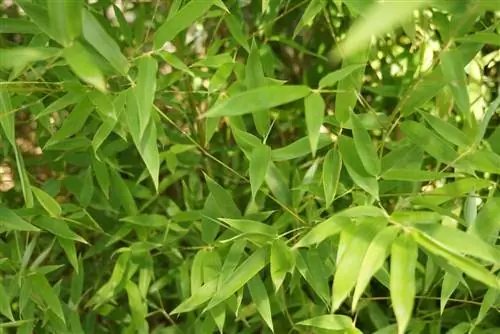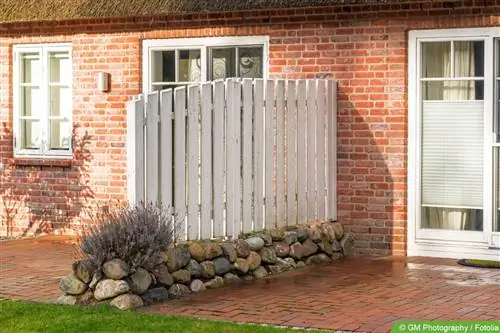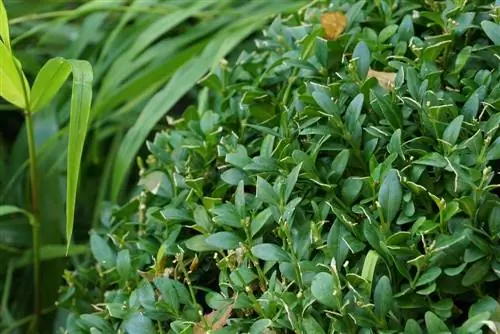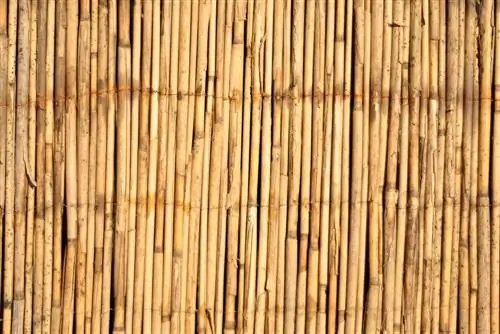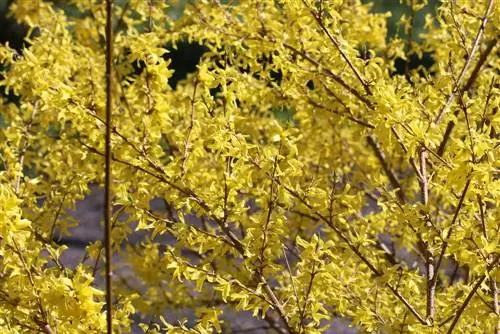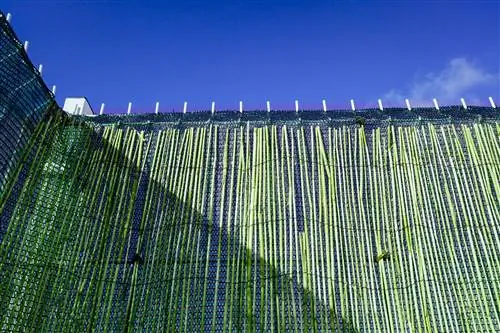- Author admin [email protected].
- Public 2023-12-17 03:39.
- Last modified 2025-01-24 12:45.
Bamboo is a cost-effective privacy screen that also keeps out the wind and therefore also dirt. It is light and natural, has an exotic look and can even be used as a climbing aid for climbing plants. But how is it best installed? This differs depending on the processing of the bamboo fence and the respective surface.
Roll goods
Bamboo privacy screens are most often offered in rolls. The individual tubes or bamboo sticks are connected to each other using thin wire. This allows the privacy screen to be flexibly attached and cut to size. The roll product is therefore ideal for railings and fences that run around corners. Even round areas can be protected from wind and secured against unwanted looks.
However, a suitable surface is required for attachment. Ideal are:
- Wooden fences
- wire mesh
- Balcony railing
Bamboo with wooden frame
Bamboo mats with a wooden frame are more stable and can also be attached between individual, narrow posts. Due to their height, they are ideal for balconies that are close together and do not have a partition. They can also be used to wonderfully protect very drafty balconies, terraces and corners in the garden from wind and prying eyes. However, the installation of the bamboo privacy screen with a wooden frame can prove to be a little more complicated.
Balcony railing
Balcony railings are usually provided with rolled goods. The installation is extremely easy. Suitable fastening materials are:
- weatherproof twine for outdoor use
- Wire with or without plastic coating
- Mat Binder
- Cable ties
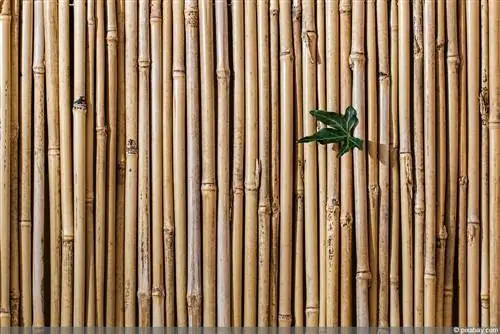
The attachment works the same in every case:
- The bamboo mat is unrolled a little, aligned and leaned against the balcony railing.
- Starting from the outside of the railing, ties, cut wire or twine are first placed around one element of the railing and then threaded between the bars of the bamboo mat.
- The ends are knotted or bent together.
- Steps 1 to 3 are repeated at regular intervals along the length of the mat. If possible, the privacy screen should be fixed to the top and bottom of the railing in order to be as stable as possible and not to slip even in strong winds.
Tip:
It is recommended to install it with two people. Especially on balconies on higher floors, having a helper to hold the mat in place is a huge relief.
Wooden fence and wooden railing
The same procedure can be used for wooden fences and railings as for attaching the bamboo mat to metal balcony railings. The mat can simply be tied down. If mat ties or covered wire are chosen, the fastening material can be color coordinated. In this way, the wire and ties on the wooden slats are less noticeable.
Tacker staples are an alternative to this. For this purpose, a hand stapler with appropriately sized staples is used. The bamboo privacy screen is held tightly to the tooth and stapled along the fence slats. A distance of 30 to 50 centimeters between the brackets usually ensures sufficient stability.
A disadvantage of this variant is that the fastening leaves holes in the wood. In addition, when the clips are removed, the privacy screen itself is usually slightly damaged. Therefore, you should be particularly careful and targeted when attaching it.
chain link fence
Attaching a privacy screen to a chain link fence is very easy. Again, wire, twine or mat ties are suitable. It becomes particularly inconspicuous if the fastening material is chosen in a matching color. To attach it, one person inserts wire or ties through the bamboo rods from the outside of the chain link fence. On the other hand, a second person can knot or close the fastening material. This means that only a few minutes are needed to attach one meter of the rolled goods. Removing the privacy screen is just as easy and leaves no trace.
Bamboo mat with frame
If bamboo mats are intended to serve as privacy and wind protection on the sides of a balcony or terrace, variants with a wooden frame are a good choice. This also applies if a corner in the garden needs to be fenced off from the outside but there is currently no fence. The attachment then of course depends on which base is available. On balconies and terraces, the railings, downpipes and wall projections are suitable fastening options. The bamboo privacy screen can be fastened as follows:
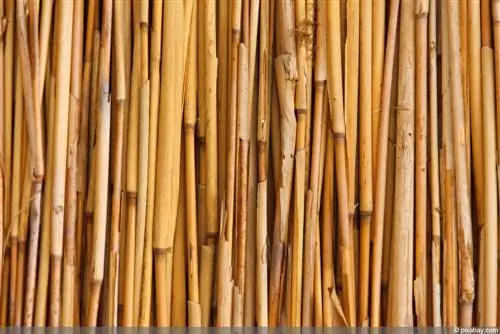
Pipes
Pipe clamps and cap brackets are placed around the pipe and can be used as a connection between the downpipe and the wooden frame using screws.
Walls
Walls are a wonderful fastening option. However, it should be clear in advance whether these can also be provided with dowels in the outdoor area of rented apartments. The wall is then provided with dowels and the wooden frame is screwed to it. A connection to the wall at the top and bottom of the frame is usually sufficient on each side. As an alternative to the direct screw connection, angle brackets can be used.
railing
Square pipe clamps are ideal for attaching to a railing. These are available as square and rectangular clamps, for corner posts and as double clamps. The fixation of the privacy screen can therefore be individually adapted to the respective circumstances.
Fence posts must be placed in the garden and without an existing base. The wooden frame of the privacy screen can be screwed to it or attached with nails.

